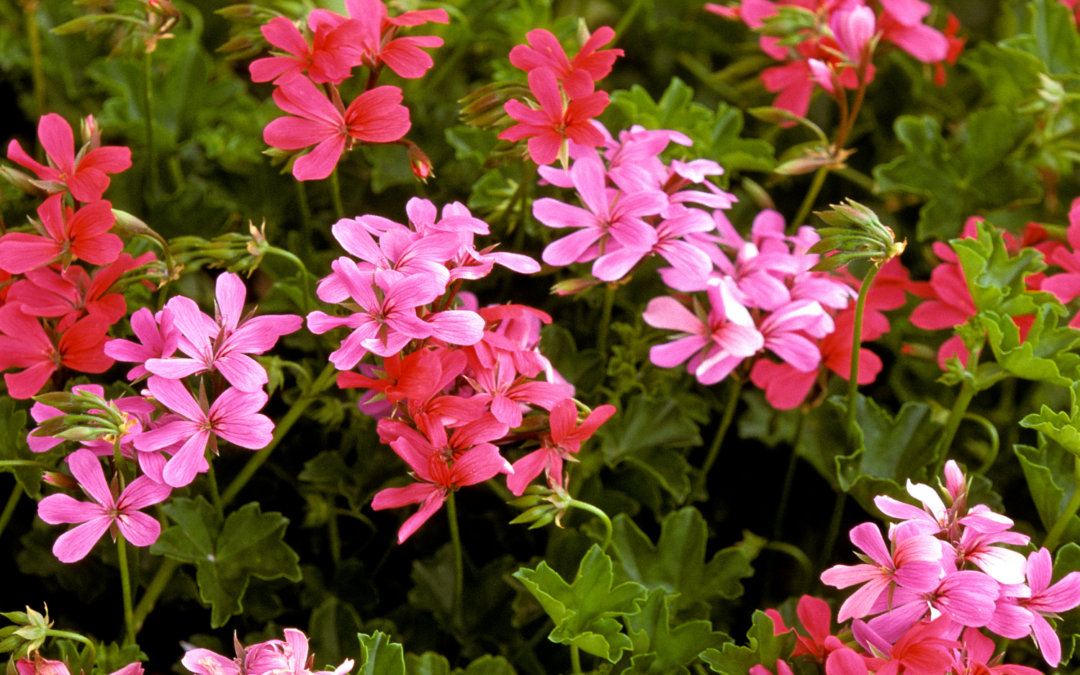Unlocking the Secrets of Geranium Essential Oil
Geranium essential oil, derived from the Pelargonium graveolens shrub, is a true aromatic gem with a multitude of therapeutic benefits. From its captivating floral rose-like scent to its healing properties, this essential oil is a must-have in your collection. Let’s dive into everything you need to know about geranium essential oil. Bonus DIY recipes with geranium essential oil.
Extraction:
Geranium essential oil is obtained through the gentle process of steam distillation. The leaves and flowers of the Pelargonium graveolens shrub release their aromatic essence, resulting in a pale yellow to greenish oil that captures the plant’s natural goodness.
Aroma:
Imagine a sweet, floral scent with hints of rose and a subtle touch of citrus. That’s the captivating aroma of geranium essential oil. Its delicate fragrance has made it a popular choice in the perfume industry, adding a touch of elegance to many fragrances.
Therapeutic Properties Of Geranium Essential Oil:
Geranium essential oil is a powerhouse of therapeutic benefits. Let’s explore some of its remarkable properties:
Antidepressant:
Lift your spirits and bid farewell to the blues. Geranium oil is believed to have mood-enhancing properties that can help alleviate symptoms of depression and anxiety, bringing a sense of upliftment and calm.
Balancing:
Hormonal imbalances can be a real challenge for many individuals. Geranium oil comes to the rescue with its hormone-balancing properties, making it beneficial for managing PMS symptoms and easing menopausal discomfort.
Menopause Harmony: Geranium Essential Oil Roller Blend
Ingredients:

With the power of essential oils, you can naturally boost your energy levels and feel revitalized throughout the day
- 10 drops Geranium essential oil
- 8 drops Clary Sage essential oil
- 6 drops Lavender essential oil
- 4 drops Peppermint essential oil
- 2 drops Frankincense essential oil
- 2 tablespoons carrier oil (e.g., sweet almond oil, or jojoba oil)
- 10ml glass roller bottle
Instructions:
- In a small bowl, combine the geranium, clary sage, lavender, peppermint, and frankincense essential oils.
- Pour the essential oil blend into a 10ml roller bottle.
- Fill the rest of the roller bottle with your chosen carrier oil. Leave a little space at the top to avoid spills when inserting the rollerball.
- Secure the rollerball and cap onto the bottle, ensuring it is tightly closed.
- Gently roll the bottle between your hands to mix the oils thoroughly.
How to Use:
- Apply the roller blend to specific areas of discomfort, such as the back of the neck, wrists, and abdomen.
- For hot flashes, apply the blend to the back of the neck and wrists and allow the cooling properties of peppermint to help ease the sensation.
- For emotional support, roll the blend onto pulse points, such as the wrists, and take deep breaths to inhale the soothing aroma.
- Use the roller blend as needed throughout the day or whenever you experience menopause-related symptoms.
Geranium essential oil can help balance hormones and improve mood, while clary sage is well-known for its potential to alleviate menopause symptoms. Lavender provides relaxation, peppermint offers a cooling effect, and frankincense can contribute to overall emotional well-being during this transitional phase.
As with any essential oil blend, it’s essential to perform a patch test on a small area of skin first, especially if you have sensitive skin or allergies. If you experience any irritation, discontinue use.
This roller blend can provide natural support during menopause, but it’s essential to remember that menopause symptoms can vary for each person. If you have specific concerns or severe symptoms, it’s always a good idea to consult with a healthcare professional.
Antimicrobial:
When it comes to battling certain bacteria and fungi, geranium oil has your back. Its antimicrobial properties can help in the fight against unwanted invaders.
Anti-inflammatory:
Show some love to your skin with geranium oil’s anti-inflammatory effects. Whether you’re dealing with eczema, acne, or other skin irritations, this oil can be your go-to for soothing relief.
Astringent:
Want to tighten those pores and achieve a more youthful appearance? Geranium oil acts as an astringent, helping to tone and reduce the appearance of pores, giving your skin a smoother and more refined look.
Diuretic:
Say goodbye to toxins as geranium oil encourages increased urination, helping your body flush out unwanted substances and promoting overall detoxification.
Skin Care:
Geranium oil is a skin superhero. With its astringent and antimicrobial properties, it’s a popular ingredient in skincare products. It can balance oil production, improve skin elasticity, and promote a clear complexion. Additionally, it’s great for treating minor wounds, cuts, and bruises.
Geranium Glow: DIY Anti-Acne and Anti-Aging Skin Care Cream
Ingredients:
- 2 tablespoons shea butter
- 1 tablespoon coconut oil
- 1 tablespoon rosehip seed oil
- 1 tablespoon jojoba oil
- 5 drops geranium essential oil
- 5 drops tea tree essential oil
- 5 drops frankincense essential oil
- 5 drops lavender essential oil
Instructions:
- In a double boiler or a heat-safe glass bowl placed over a pot of simmering water, melt the shea butter and coconut oil together. Stir gently until they are completely melted and combined.
- Remove the mixture from heat and let it cool for a few minutes.
- Add the rosehip seed oil and jojoba oil to the melted mixture. These carrier oils are excellent for moisturizing the skin and providing nutrients.
- Once the mixture has cooled down a bit (but is still liquid), add the geranium, tea tree, frankincense, and lavender essential oils.
- Stir the mixture thoroughly to ensure all the oils are well incorporated.
- Transfer the cream to a clean, airtight container or jar.
- Allow the cream to cool and solidify completely before using it.
How to Use:
- After cleansing your face, take a small amount of the DIY skin care cream and apply it to your face and neck, focusing on areas with acne or signs of aging.
- Gently massage the cream into your skin using upward circular motions.
- Use the cream twice a day – once in the morning and once before bedtime.
Geranium essential oil is known for its balancing properties, which can be beneficial for both oily and dry skin types. It can help regulate sebum production and promote a healthy complexion. Tea tree oil is well-known for its anti-acne properties, helping to combat bacteria that may cause breakouts. Frankincense and lavender essential oils have anti-aging properties and can contribute to reducing the appearance of fine lines and wrinkles.
Keep in mind that essential oils are potent, so if you have sensitive skin or any allergies, it’s essential to do a patch test before applying the cream to your face. If you experience any irritation, discontinue use and consult a healthcare professional.
This DIY skin care cream with geranium essential oil and other essential oils can be a valuable addition to your daily skincare routine, helping to address acne and signs of aging in a natural and nourishing way.
Emotional Well-being:
Unwind, relax, and let your worries drift away. Geranium essential oil is known for its calming and uplifting effects on emotions. It’s an excellent choice for reducing stress, enhancing relaxation, and overall feeling of well-being.
Insect Repellent:
Bugs bugging you? Geranium oil to the rescue! Its naturally strong scent acts as a repellent, making it a great natural alternative to chemical-based insect repellents.
Bug Off Insect Repellent

Happy campers use essential oil.
Ingredients:
- 15 drops of geranium essential oil
- 10 drops of citronella essential oil
- 10 drops of lavender essential oil
- 10 drops of lemon grass essential oil
- 5 drops of peppermint essential oil
- 2 tablespoons of a carrier oil (e.g. sweet almond oil, or jojoba oil)
- A small spray bottle (about 4 ounces in size)
Instructions:
- Select a small spray bottle that will hold around 4 ounces of liquid. Make sure it is clean and dry before using.
- In a small bowl, combine all the essential oils: geranium, citronella, lavender, lemon grass, and peppermint.
- Add the 2 tablespoons of carrier oil to the bowl with the essential oils. Carrier oils help dilute the essential oils and ensure safe application to the skin.
- Mix the oils together thoroughly to create a well-blended insect repellent blend.
- Carefully pour the mixture into the spray bottle using a funnel if necessary.
- Close the spray bottle tightly and give it a gentle shake to ensure the oils are well combined.
- Your DIY insect repellent is ready to use! Before each use, give the bottle a quick shake to mix the oils again.
How to Use:
- Apply the repellent to exposed skin areas, such as arms and legs, avoiding the eyes and mouth.
- Reapply the repellent every couple of hours or as needed, especially if you’re sweating or swimming.
- Always do a patch test before applying the repellent to a larger area of skin, especially if you have sensitive skin or allergies.
Blending Geranium Essential Oil For Aromatic Bliss:
Geranium oil loves to mingle with other essential oils, creating unique and delightful aromas. Here are some companions that blend well with geranium:
- Lavender: Find ultimate relaxation and serenity.
- Rosemary: Boost mental clarity and focus.
- Bergamot: Bring a burst of uplifting citrus.
- Lemon: Refresh and invigorate your senses.
- Patchouli: Embrace earthy and exotic vibes.
Get creative with these blends and unlock a world of aromatic possibilities!
Precautions for Safe Use:
While geranium essential oil is generally safe for most people, it’s essential to keep a few precautions in mind:
- Perform a patch test before applying the oil topically to ensure you don’t have any adverse reactions.
- If you’re pregnant, consult with a healthcare professional before using essential oils.
- Remember that essential oils are highly concentrated, so always follow proper dilution guidelines.
- For personalized usage recommendations, consult with a qualified aromatherapist or healthcare practitioner.
Unlocking Geranium Essential Oil Chemistry:
Geranium essential oil derives its unique characteristics from its chemical components. Let’s explore some of the key players:
-
Citronellol:
Adds a touch of antimicrobial power and contributes to the oil’s floral and rosy aroma.
-
Geraniol:
A prominent compound with a rose-like scent, widely used in the fragrance industry. It offers antimicrobial and anti-inflammatory properties.
-
Linalool:
Known for its calming effects and floral scent, linalool brings relaxation and tranquility to geranium oil.
-
Citronellyl formate:
This compound adds a fruity note, enhancing the complexity of the oil’s aroma.
-
Geranyl formate:
With its fruity and slightly spicy character, geranyl formate adds a unique twist to the overall scent profile.
-
Beta-caryophyllene:
A beneficial compound with anti-inflammatory properties that contributes to the potential therapeutic benefits of geranium oil.
-
Citral:
Responsible for the refreshing citrus-like scent and acts as a natural insect repellent.
These chemical components work together in harmony, creating a symphony of therapeutic effects.
Unveiling the Science: GC-MS Analysis
Ever wondered how essential oils are analyzed for their chemical composition? Gas chromatography-mass spectrometry (GC-MS) is the magic behind it. Here’s a glimpse into the process:
Sample Preparation:
A small amount of the essential oil is diluted in a solvent, enabling proper vaporization and analysis.
Gas Chromatography (GC):
The diluted oil sample is injected into a gas chromatograph, which separates the individual chemical components based on their physical and chemical properties. This separation allows for further analysis.
Mass Spectrometry (MS):
As the components exit the GC column, they enter the mass spectrometer. Through ionization, fragmentation, and sorting based on the mass-to-charge ratio, a mass spectrum is generated, revealing the unique fingerprint of the components.
Data Analysis:
The obtained mass spectrum is compared to a reference database to identify the components based on their spectra, retention times, and other factors. The software quantifies the components by peak intensities.
Reporting:
The GC-MS analysis results are compiled into a report, providing a list of identified components, their concentrations, and additional information, such as retention times or area percentages.
GC-MS analysis ensures quality control, consistency, and identification of adulteration or contaminants. Trained professionals conduct this analysis in specialized laboratories, guaranteeing the safe and effective use of essential oils. Always check the GC-MS report before purchasing an essential oil to ensure purity.
In Conclusion
With the knowledge of geranium essential oil’s extraction process, therapeutic properties, and chemical composition, you’re equipped to harness its benefits effectively and responsibly.
Essential oils are nature’s gifts, offering an aromatic journey that supports well-being and elevates your daily rituals. Enjoy the floral bliss and let geranium essential oil become your ally in emotional balance, skin care, and a fragrant sanctuary of self-care! This sums up Everything you need to know about geranium essential oil.
Have fun creating a life that naturally makes scents!
Read Next:
The Power Of Pure Rose Essential Oil
Become a certified aromatherapist.
As a disclaimer, I earn a small commission if you choose to use the product links in this article however this does not change the price of any products. Thank you



